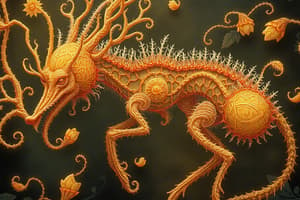Podcast
Questions and Answers
After implantation, the blastocyst is referred to as an embryo. (True/False)
After implantation, the blastocyst is referred to as an embryo. (True/False)
True (A)
The umbilical cord functions as the embryo's lifeline to receive oxygen and food from the mother. (True/False)
The umbilical cord functions as the embryo's lifeline to receive oxygen and food from the mother. (True/False)
True (A)
At seven months, the fetus has developed eyelashes and recognizable eyelids. (True/False)
At seven months, the fetus has developed eyelashes and recognizable eyelids. (True/False)
True (A)
The developing embryo is enclosed in a sac of a thin sheet of tissue called the ______ sac
The developing embryo is enclosed in a sac of a thin sheet of tissue called the ______ sac
The bond that holds the embryo to the wall of the uterus is called the ______
The bond that holds the embryo to the wall of the uterus is called the ______
After two months, the embryo is about 1.2 inches (3 centimeters) long and has a recognizable human form or a ______
After two months, the embryo is about 1.2 inches (3 centimeters) long and has a recognizable human form or a ______
Flashcards are hidden until you start studying
Study Notes
Gametogenesis and Fertilization
- Gametogenesis is the formation of gametes (sperm and egg) inside the reproductive systems under parental genetic control.
- Fertilization is the union of a sperm cell from a male and an egg cell from a female, resulting in the fusion of their nuclei.
Cleavage and Blastulation
- After fertilization, the zygote undergoes a series of mitotic cell divisions, resulting in cleavages.
- This stage is characterized by rapid cell division, resulting in the formation of a fluid-filled cavity inside the developing embryo.
Gastrulation
- Gastrulation is the stage where cell migration patterns are organized in the embryo to form the three germ layers (ectoderm, endoderm, and mesoderm).
- These germ layers will eventually form all organs of the animal body.
Growth and Tissue Specialization
- In this final stage, organs acquire their unique structures and chemical properties.
- This is a result of cell differentiation and formation of all major organs after the germ layers have formed.
Studying That Suits You
Use AI to generate personalized quizzes and flashcards to suit your learning preferences.




